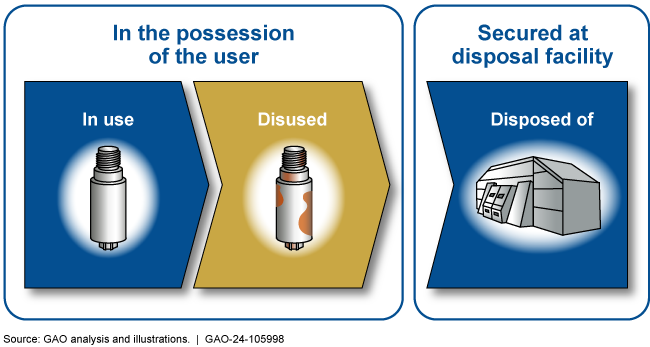High-Risk Radioactive Material: Opportunities Exist to Improve the Security of Sources No Longer in Use
Fast Facts
"Radioactive sources" refers to nuclear materials that emit radiation and are sealed in containers that are specifically designed for use in medical, industrial, or research applications. For example, cesium-137 is widely used in a device that irradiates donor blood to make it safer for transfusions.
These radioactive sources can only be used for a defined period—based on radioactive half-life—but some users delay disposal, leaving sources vulnerable to theft. Cost and difficulty of disposal are 2 of the causes we found for delays.
Our recommendations are for federal agencies to incentivize users to promptly dispose of radioactive sources.

Highlights
What GAO Found
Licensees of high-risk radioactive sources may delay disposing of sources that are in their possession but no longer in use (i.e., disused) for a variety of reasons. For example, the U.S. Nuclear Regulatory Commission (NRC) does not require licensees to dispose of radioactive sources unless a licensee is terminating all activities under its license at specific locations. In addition, some high-risk sources containing radioactive materials that have a long life cycle, including cesium-137 and americium-241, have limited disposal pathways that may require government assistance or may not have a viable disposal pathway at all. Specifically, sources used in the oil and gas industry that contain americium-241 of foreign origin currently have no permanent disposal pathway, leaving them vulnerable to loss or abandonment.
Disused High-Risk Radioactive Sources at a Source Processing Facility

GAO identified leading practices supported by key entities—such as the International Atomic Energy Agency—that are not reflected in NRC requirements and could help address some disposal challenges. These practices include tracking sources, imposing limits and fees on possession, or collecting financial assurances at the time a source is purchased to offset later disposal costs. Assessing adoption of these leading practices nationwide may more broadly incentivize timely disposal, potentially reduce overall cost to the government, and reduce the risk that radioactive sources could be used in a dirty bomb.
Why GAO Did This Study
Radioactive sources are commonly used for medical, industrial, and research purposes. However, these materials can be harmful and dangerous, if used improperly.
NRC and states to which it has delegated authority issue licenses for the possession and use of radioactive sources. These entities regulate disposal facilities that can accept certain sources and waste. Several federal programs support disposal of some sources, but some licensees still hold onto sources beyond their useful lives. Doing so increases the risk that sources could be orphaned and misused, for example, in a dirty bomb.
House Report 117-118 accompanying a bill for the National Defense Authorization Act for Fiscal Year 2022 includes a provision for GAO to review the disposition of radioactive sources. This report examines (1) the factors that contribute to licensees delaying disposal of disused high-risk radioactive sources, and (2) leading practices that, if implemented, could help address challenges related to the disposal of some disused radioactive sources. GAO reviewed relevant laws, regulations, and key organizations' documents on leading practices. GAO also interviewed agency and industry officials and conducted site visits.
Recommendations
GAO is making three recommendations, including that NRC should assess leading practices that would minimize the time that disused sources are in a licensee's possession. NRC neither agreed nor disagreed with this recommendation, and the agencies generally agreed with the other two recommendations.
Recommendations for Executive Action
| Agency Affected | Recommendation | Status |
|---|---|---|
| Department of Energy | The Secretary of Energy, in coordination with the NRC and in consultation with other relevant stakeholders, should conduct an analysis to evaluate options and take action to facilitate long-term storage, within agency authorities, to better secure foreign-origin americium-241 until a permanent disposal or viable recycling option is available. (Recommendation 1) |
As of March 2024, this recommendation has not been implemented. We will follow-up with the agency and update the status of the recommendation when we have additional information.
|
| Nuclear Regulatory Commission |
Priority Rec.
The Chairman of the NRC, in coordination with DOE and in consultation with other relevant stakeholders, should conduct an analysis to evaluate options and take action to facilitate long-term storage, within agency authorities, to better secure foreign-origin americium-241 until a permanent disposal or viable recycling option is available. (Recommendation 2) |
In July 2024, NRC officials stated that current regulations and oversight programs facilitate licensees' safe, long-term storage of sources awaiting a disposal pathway. They stated that NRC will continue to participate in relevant interagency activities, but that NNSA is the appropriate agency to lead and conduct any analysis required to develop a disposition solution. If required, the NRC is prepared to license a facility the NNSA determines is a viable option to store foreign-origin americium-241.
|
| Nuclear Regulatory Commission | The Chairman of the NRC should comprehensively assess leading practices that, if implemented, would minimize the time that disused sources are in a licensee's possession. These practices include financial assurances for all category 1, 2, and 3 sources; tracking of category 3 sources; possession time limits or fees for disused sources; and orphan source funds. (Recommendation 3) |
In July 2024, NRC officials stated NRC will evaluate 1) the merits and practicality of time limits and fees for sources not actively being used and 2) authorities required to establish an orphan source fund. NRC staff are also currently developing a regulatory basis for a rulemaking that would consider whether financial assurance requirements should be extended to category 3 sources. However, in 2017, NRC staff recommended the Commission not pursue rulemaking to amend NRC regulations to require inclusion of category 3 sources in NSTS. In December 2021, the Commission documented its agreement with staff's recommendation. In February 2024, NRC staff told us NRC has no further plans to consider including category 3 sources in NSTS.
|
